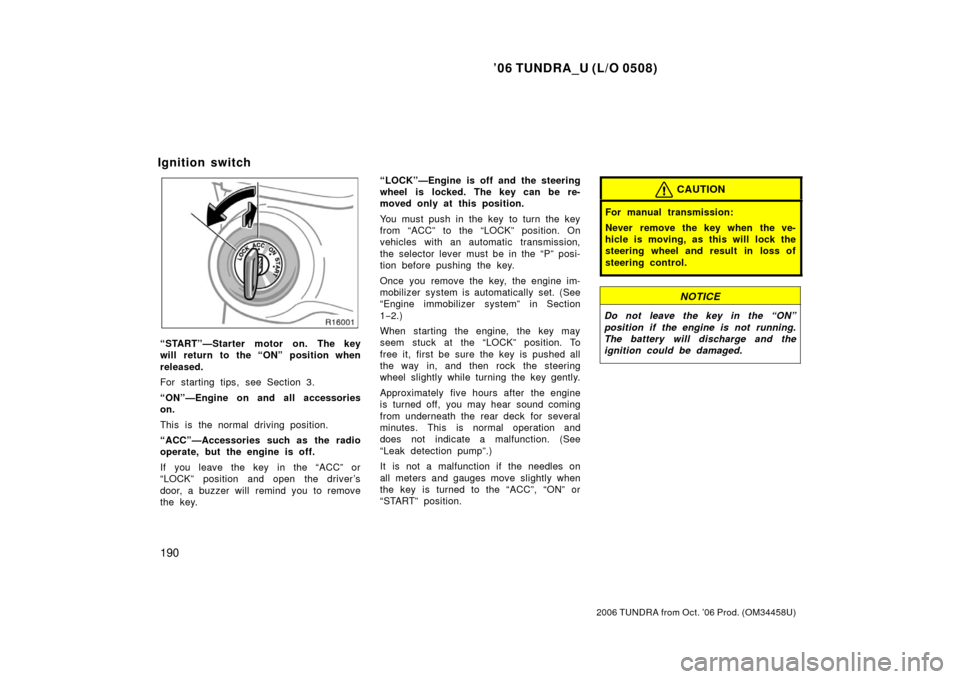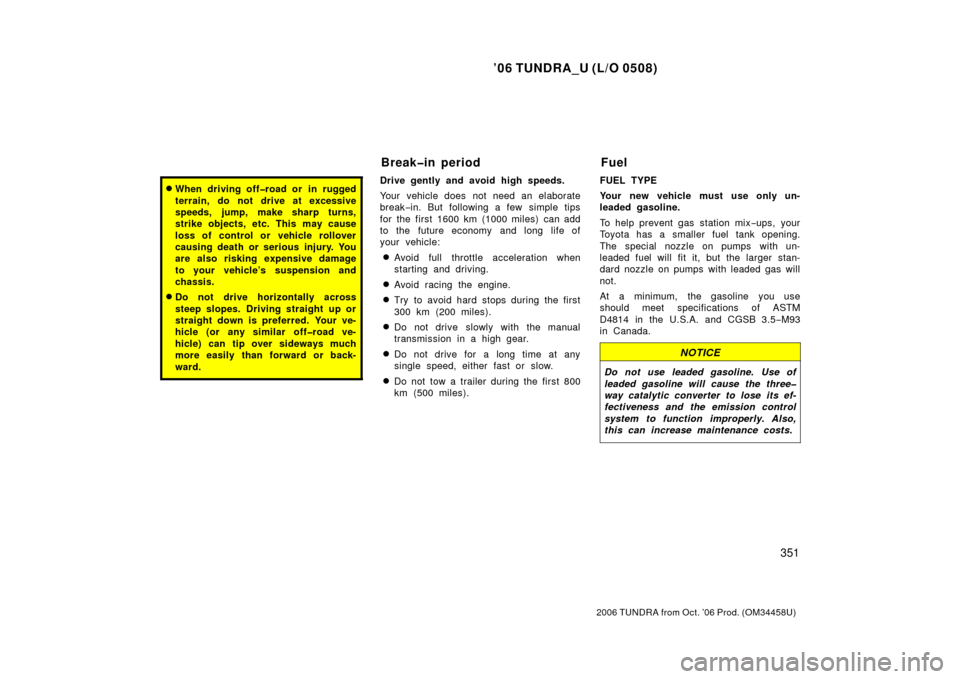Page 4 of 527

’06 TUNDRA_U (L/O 0508)
iv
2006 TUNDRA from Oct. ’06 Prod. (OM 34458U)
In order to be effective, the SRS airbags must deploy with
tremendous speed. The rapid deployment of the SRS air-
bags makes the SRS airbags themselves potential sources
of serious injury if an occupant is too close to an airbag,
or if an object or some part of his or her body has been
placed between the occupant and the airbag at the time of
deployment. This is just one example of how the instruc-
tions in Section 1−3 of this Owner ’s Manual will help en-
sure proper use of the occupant restraint systems, and
increase the safety they can provide to you and your fami-
ly in the event of an accident.
Toyota recommends you to read the provisions in Section
1 −3 carefully and refer to them as needed during your time
of ownership of this vehicle.Event data recorder
Your vehicle has computers that monitor and control cer-
tain aspects of your vehicle. These computers assist in
driving and maintaining optimal vehicle performance. Be-
sides storing data useful for troubleshooting, there is a
system to record data in a crash or a near car crash
event. This is called an Event Data Recorder (EDR).
The SRS airbag sensor assembly contains the EDR. In a
crash or a near car crash event, this device may record
some or all of the following information:
� Engine speed
� Whether the brake pedal was applied or not
� Vehicle speed
� To what extent the accelerator pedal was depressed
� Position of the transmission selector lever
� Whether the driver and front passenger wore the seat
belts or not
� Driver’s seat position
� Front passenger ’s occupant classification
Page 14 of 527
’06 TUNDRA_U (L/O 0508)
2
2006 TUNDRA from Oct. ’06 Prod. (OM 34458U)
1. Side vents
2. Instrument cluster
3. Center vents
4. Personal lights
5. Garage door opener box or auxiliary
box
6. Side defroster outlet
7. Glove box
8. Power door lock switches
9. Power window switches
10. Manual transmission gear shift lever
11. Rear console box
12. Cup holders
13. Parking brake lever
14. Tire pressure warning system reset switch
15. Lower vent
16. Hood lock release lever
17. Window lock switch
18. Power rear view mirror control switches
Instrument panel overview
(standard and access cab models)
� Vehicles with manual transmission
Page 17 of 527
’06 TUNDRA_U (L/O 0508)
5
2006 TUNDRA from Oct. ’06 Prod. (OM 34458U)
1. Outside rear view mirror heater switch
2. Power back window switch
3. Headlight, turn signal and front fog
light switches
4. Ignition switch
5. Wiper and washer switches
6. Automatic transmission shift position “L” switch (“SHIFT L” switch)
7. Emergency flasher switch
8. Audio system or navigation system including audio system
(For the navigation system, see the
separate “Navigation System Owner ’s
Manual”)
9. Air conditioning controls
10. Front passenger ’s occupant classification indicator light/front
passenger ’s seat belt reminder
light/passenger airbag off indicator light
11. Cargo lamp switch
12. Clock
13. “4LO” switch (transfer mode selector switch)
14. Cup holder
Page 21 of 527
’06 TUNDRA_U (L/O 0508)
9
2006 TUNDRA from Oct. ’06 Prod. (OM 34458U)
1. Power back window switch
2. Power rear view mirror control switches
3. Roll sensing of curtain shield airbags
off switch (“RSCA OFF” switch)
4. Instrument panel light control knob
5. Headlight, turn signal and front fog light switches
6. Wiper and washer switches
7. Automatic transmission selector lever
8. Automatic transmission shift position “L” switch (“SHIFT L” switch)
9. Audio system or navigation system including audio system
(For the navigation system, see the
separate “Navigation System Owner ’s
Manual”)
10. Air conditioning controls 11. Front passenger ’s occupant classification indicator light/front
passenger ’s seat belt reminder light
12. Cargo lamp switch
13. Back window and outside rear view mirror defogger switch
14. Clock
15. Cup holder
16. Power outlets
17. Ashtray
Page 201 of 527

’06 TUNDRA_U (L/O 0508)
189
2006 TUNDRA from Oct. ’06 Prod. (OM 34458U)
OPERATION OF INSTRUMENTS AND
CONTROLS
Ignition switch, Transmission and Parking brake
Ignition switch 190
. . . . . . . . . . . . . . . . . . . . . . . . . . . . . . . . . . . . .\
. . . . . . . . .
Automatic transmission 191
. . . . . . . . . . . . . . . . . . . . . . . . . . . . . . . . . . . . \
.
Manual transmission 195
. . . . . . . . . . . . . . . . . . . . . . . . . . . . . . . . . . . . \
. . . .
Four −wheel drive system 196
. . . . . . . . . . . . . . . . . . . . . . . . . . . . . . . . . . . . \
Traction control system 199
. . . . . . . . . . . . . . . . . . . . . . . . . . . . . . . . . . . . \
. .
“AUTO LSD” system 201
. . . . . . . . . . . . . . . . . . . . . . . . . . . . . . . . . . . . \
. . . .
Vehicle stability control system 204
. . . . . . . . . . . . . . . . . . . . . . . . . . . . . . .
Tire pressure warning system 207
. . . . . . . . . . . . . . . . . . . . . . . . . . . . . . . .
Parking brake 213
. . . . . . . . . . . . . . . . . . . . . . . . . . . . . . . . . . . . \
. . . . . . . . . .
Cruise control 214
. . . . . . . . . . . . . . . . . . . . . . . . . . . . . . . . . . . . \
. . . . . . . . . .
SECTION 1� 7
Page 202 of 527

’06 TUNDRA_U (L/O 0508)
190
2006 TUNDRA from Oct. ’06 Prod. (OM 34458U)
“START”—Starter motor on. The key
will return to the “ON” position when
released.
For starting tips, see Section 3.
“ON”—Engine on and all accessories
on.
This is the normal driving position.
“ACC”—Accessories such as the radio
operate, but the engine is off.
If you leave the key in the “ACC” or
“LOCK” position and open the driver’s
door, a buzzer will remind you to remove
the key. “LOCK”—Engine is off and the steering
wheel is locked. The key can be re-
moved only at this position.
You must push in the key to turn the key
from “ACC” to the “LOCK” position. On
vehicles with an automatic transmission,
the selector lever must be in the “P” posi-
tion before pushing the key.
Once you remove the key, the engine im-
mobilizer system is automatically set. (See
“Engine immobilizer system” in Section
1
−2.)
When starting the engine, the key may
seem stuck at the “LOCK” position. To
free it, first be sure the key is pushed all
the way in, and then rock the steering
wheel slightly while turning the key gently.
Approximately five hours after the engine
is turned off, you may hear sound coming
from underneath the rear deck for several
minutes. This is normal operation and
does not indicate a malfunction. (See
“Leak detection pump”.)
It is not a malfunction if the needles on
all meters and gauges move slightly when
the key is turned to the “ACC”, “ON” or
“START” position.
CAUTION
For manual transmission:
Never remove the key when the ve-
hicle is moving, as this will lock the
steering wheel and result in loss of
steering control.
NOTICE
Do not leave the key in the “ON”
position if the engine is not running.
The battery will discharge and the
ignition could be damaged.
Ignition switch
Page 207 of 527

’06 TUNDRA_U (L/O 0508)
195
2006 TUNDRA from Oct. ’06 Prod. (OM 34458U)
The shift pattern is as shown above.
In case of driving your vehicle, the buzzer
will sound when you shift the gear into
“R” (reverse).
Press the clutch pedal down fully while
shifting, and then release it slowly. Do not
rest your foot on the pedal while driving,
because it will cause clutch trouble. Do
not use the clutch to hold the vehicle
when stopped on an uphill grade—use the
parking brake. Recommended shifting speeds
The transmission is fully synchronized and
upshifting or downshifting is easy.
For the best compromise between fuel
economy and vehicle performance, you
should upshift or downshift at the following
speeds:
gear km/h (mph)
1 to 2 or 2 to 1 24 (15)
2 to 3 or 3 to 2 40 (25)
3 to 4 or 4 to 3 64 (40)
4 to 5 or 5 to 4 72 (45)
5 to 6 or 6 to 5 80 (50)
Downshift to the appropriate gear if accel-
eration is needed when you are cruising
below the above downshifting speeds.
Upshifting too soon or downshifting too
late will cause lugging, and possibly ping-
ing. Regularly revving the engine to maxi-
mum speed in each gear will cause ex-
cessive engine wear and high fuel
consumption. Maximum allowable speeds
To get on a highway or to pass slower
traffic, maximum acceleration may be nec-
essary. Make sure you observe the follow-
ing maximum allowable speeds in each
gear:
gear km/h (mph)1 45 (28)
2 90 (56)
3 130 (81)
4 165 (112)
NOTICE
Do not downshift if you are going
faster than the maximum allowable
speed for the next lower gear.
Manual transmission
Page 363 of 527

’06 TUNDRA_U (L/O 0508)
351
2006 TUNDRA from Oct. ’06 Prod. (OM 34458U)
�When driving off�road or in rugged
terrain, do not drive at excessive
speeds, jump, make sharp turns,
strike objects, etc. This may cause
loss of control or vehicle rollover
causing death or serious injury. You
are also risking expensive damage
to your vehicle’s suspension and
chassis.
�Do not drive horizontally across
steep slopes. Driving straight up or
straight down is preferred. Your ve-
hicle (or any similar off�road ve-
hicle) can tip over sideways much
more easily than forward or back-
ward.
Drive gently and avoid high speeds.
Your vehicle does not need an elaborate
break−in. But following a few simple tips
for the first 1600 km (1000 miles) can add
to the future economy and long life of
your vehicle:
�Avoid full throttle acceleration when
starting and driving.
�Avoid racing the engine.
�Try to avoid hard stops during the first
300 km (200 miles).
�Do not drive slowly with the manual
transmission in a high gear.
�Do not drive for a long time at any
single speed, either fast or slow.
�Do not tow a trailer during the first 800
km (500 miles). FUEL TYPE
Your new vehicle must use only un-
leaded gasoline.
To help prevent gas station mix
−ups, your
Toyota has a smaller fuel tank opening.
The special nozzle on pumps with un-
leaded fuel will fit it, but the larger stan-
dard nozzle on pumps with leaded gas will
not.
At a minimum, the gasoline you use
should meet specifications of ASTM
D4814 in the U.S.A. and CGSB 3.5 −M93
in Canada.
NOTICE
Do not use leaded gasoline. Use of
leaded gasoline will cause the three�
way catalytic converter to lose its ef-
fectiveness and the emission control
system to function improperly. Also,
this can increase maintenance costs.
Break�in period Fuel